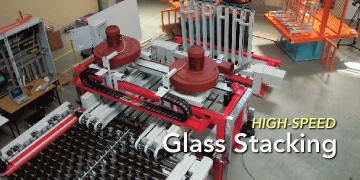April 3, 2009

A new generation of glass-handling equipment is emerging, which its developers say is destined to change the landscape of cold-end, processing line efficiencies. Every function of the cold-end line is being integrated into one controls automation platform including transfer of the glass, cutting the glass ribbon into sheets of optimum size, glass snapping, rejection of faulty glass sheets, sorting according to size and quality and stacking into glass racks with robotics.
Developed by Grenzebach, in tandem with Siemens, this new line of glass-handling equipment features integrated control systems that provide a fully automated solution to the handling of finished float glass.
Of all the functions on the float glass line, stacking remains the most labor intensive, and is a key target for automation. Some producers have automated stacking in the past, but have still experienced throughput difficulties and glass breakage problems. Many float glass producers are still handling stacking manually without the aid of any controls automation.
The first piece of Grenzebach equipment to exclusively utilize this automation technology is the company's new high-speed stacker. Designed to increase the glass manufacturer's efficiency and flexibility, it was developed for stacking small glass formats with high cycle times, and the company claims it is currently the only system which can stack glass sheets with less than a one-second cycle time.
A robot-assisted float glass stacker, the system forms sub-packs of glass and achieves flexibility by stacking sub-packs with a robot. The stacker creates glass formats up to 73 x 97 inch and then transports glass sheets by a suction belt into a packet frame where each sheet is placed successively until a sub-pack has been created. Next, the packet is transported to a robot for take-off, either from above or from the side, to be stored on a glass rack used to transport the product to other facility locations or end customers.
The system's six-axis robots are capable of correcting the stacking alignment and creating precise glass stacks. For small glass sheets, two packets are built up and stacked in parallel. Using this production method, up to 80 glass plates per minute can be taken off and stacked. The robots have a payload capacity of up to 220 lb and also feature integrated energy supply systems to reduce floor space.
The machine can stack multiple sizes of glass with varying orientation including landscape or portrait, tin side in or tin side out with speed and accuracy. The stacker offers manufacturers the flexibility to adapt to product variations and feeding can be performed in a double stream configuration, so two packets are built up and stacked in parallel.
Grenzebach's totally automated cold-end line is functionally based on Siemens' concept of Totally Integrated Automation (TIA). SIMOTION(R) products provide interoperability covering the controller, HMI, drives and up to the process control system.
The Grenzebach machines require motion control for positioning and synchronous operation, PLC functionality and technology tasks for functions such as pressure and temperature control. Integrated with SIMOTION is Siemens' SIMATIC(R) S7-300 automation system. Applicable for centralized and distributed configurations, it has the ability to integrate powerful CPUs using an Industrial Ethernet/PROFINET interface. These technologies provide a powerful combination of motion control, PLC and technology functions in one unit.
The Siemens' S7 controllers are SIMATIC Safety Integrated and can monitor themselves, detect faults autonomously and immediately change into or remain in a safe mode when a fault occurs. Fail-safe CPUs are utilized for safety-oriented applications with the stacker and all other equipment on the cold-end line. The PROFIsafe profile for safe communication via PROFIBUS and PROFINET allows integration of safety-related functions.
About the Author(s)
You May Also Like





